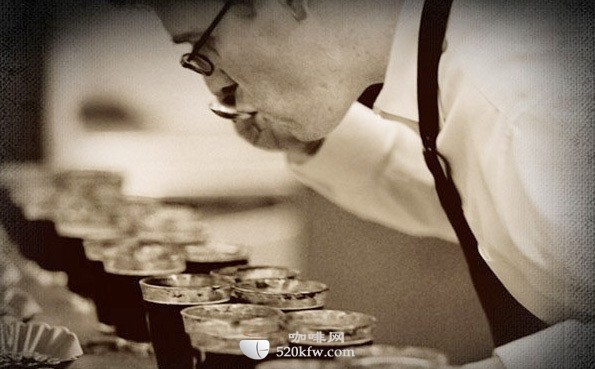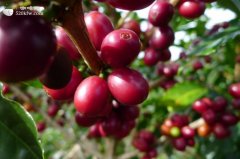Six steps of coffee cup evaluation
There are six steps in coffee cup evaluation, describing the aroma, aroma, taste, smell, aftertaste and mellowness of coffee.

1. Fragrance: the first step in cup evaluation is to evaluate the aroma of coffee beans. Grind 10 grams of coffee, put it in 3-5 sample cups, and then breathe hard at the gas released by the freshly crushed coffee cells. The characteristics of the aroma indicate the essence of the taste of coffee beans: the sweet smell indicates that its taste is sour; the pungent smell indicates that its taste is irritating. The strength of the aroma indicates the freshness of the coffee, that is, the time it takes from roasting to grinding into powder. The aroma consists of the most volatile aromatic compounds, especially those containing sulfur, such as methyl mercaptan. At present, there is little people can do about how to keep these substances in coffee beans.
two。 Aroma: the second step in cup review is to check the aroma of coffee water. First, pour 150ml of boiled fresh (oxidized) water into the freshly ground coffee powder and let the coffee powder soak in water for 3-5 minutes. Coffee powder forms a cap-shaped shell on top of the water. Stir the coffee with a coffee spoon and break the cap shell. At this time, the caffeine hot water will release the gas into the nasal cavity, so that the nasal diaphragm feel a comprehensive flavor: from fruit, grass, to nutty. The experience of cup review will cause cup reviewers to classify coffee according to the memory of various coffee smells. In the future, different kinds of coffee can be distinguished according to different odors. Generally speaking, the aroma characteristics of coffee are related to the origin of coffee. Correspondingly, the strength of the aroma is related to the freshness of coffee. Freshness is measured by the length of time from baking to cooking. Freshness is also affected by the type of packaging that protects coffee from dampness and non-oxidation.
3. Taste (Taste): carefully savoring the taste of freshly brewed coffee is the third step in cup review coffee. Use a special coffee spoon, usually a round spoon with a capacity of 8 ~ 10cc. Preferably silver-plated, which can dissipate heat quickly. Take out 6 ~ 8cc of coffee water and put it in front of your mouth and sip it hard. Quickly inhale coffee and distribute it evenly on the surface of the tongue. All sensory nerve terminals respond to sweet, salty, sour and bitter tastes at the same time. Because temperature affects the degree of stimulation, paying attention to responses in different sensitive areas of the tongue can help capture different characteristics. For example, because temperature reduces sensitivity to the sweetness of sugar, acidic coffee initially produces a tingling on the tip of the tongue rather than sweetness. Hold the coffee in your mouth for 3-5 seconds and focus on the type and intensity of the taste. In this way, primary and secondary flavor characteristics can be evaluated.
4. Nose: the fourth step is the same as the third step. Inhale coffee through the surface of the tongue. Due to the change of water vapor pressure, part of the organic matter in the water changes from liquid to gaseous state. The act of sucking coffee hard causes the gas to enter the nasal cavity, allowing cup reviewers to analyze the smell of coffee. At the same time, evaluate the taste and smell of coffee, so that cup reviewers feel the unique flavor characteristics of coffee. Standard roasted coffee usually has the taste of caramelized products, while deep-roasted coffee usually has the taste of dry distillation products.
5. Aftertaste (Aftertaste): the fifth step is to put coffee water in your mouth for a few seconds, then swallow a small part. Quickly suck the throat to send the water vapor left in the back palate into the nasal cavity, you can find the smell of the heavier molecules left in the back palate. The aromas of various compounds felt in the aftertaste are sweet, similar to chocolate; or bonfire smoke, or cigar smoke; sometimes, there are similar irritating spices, such as cloves; sometimes, like resin, similar to turpentine; sometimes, there are all these smells. 6. Body: the final stage of cup review is to evaluate the taste of coffee water. The tongue slips gently across the palate of the mouth to feel the texture of the coffee. For oily quality and smooth range
The feeling of degree can measure the fat content in coffee water, while the "heavy", thick and sticky feeling of coffee can measure the fiber and protein content of coffee. The two make up the mellowness of coffee.
Important Notice :
前街咖啡 FrontStreet Coffee has moved to new addredd:
FrontStreet Coffee Address: 315,Donghua East Road,GuangZhou
Tel:020 38364473
- Prev

Taste boutique coffee bean technology coffee cup test 90 +
NinetyPlus, literally translated as 90 cents, means that the young coffee company sells raw coffee beans with a Cupping score of more than 90 points. Some friends may think that it is not a big deal to score more than 90 points, but if they understand this set of Cupping rules, they will keep their mouth shut: after more than a dozen strict requirements of the inverted deduction system, the remaining 90 points is no less difficult than writing.
- Next

Boutique Coffee Technology of preserving Coffee beans and Coffee Powder
Dark coffee seems lonely, but it is not: milk, cream balls, ice cream, rock sugar, sweet wine, chocolate rice and colorful rice are all good friends of coffee. [how to preserve coffee beans] roasted coffee beans are easily oxidized by contact with air, resulting in deterioration of the oil, volatilization and disappearance of the fragrance, and then added by temperature, humidity, sunlight and other factors.
Related
- What is the meaning of lactic acid fermentation with coffee bean treatment?
- How to judge the state of foam by sound?
- How does the latte pull out the unicorn pattern? Come to get for a little trick to improve the flower pull!
- Will flower pulling affect the taste of the latte?
- Do you know the history of coffee?
- The difference between honey treatment and sun washing what is raisin honey treatment?
- What kind of milk can a novice use to make coffee foam to keep the foam longer? The correct method and skills of milking tutorial sharing
- Why do washed coffee beans taste sour? Flavor characteristics of washed Coffee
- Introduction to the skill of how to practice the size and height of water injection around the circle of hand-brewed coffee
- How do beginners practice coffee flower drawing from scratch?

